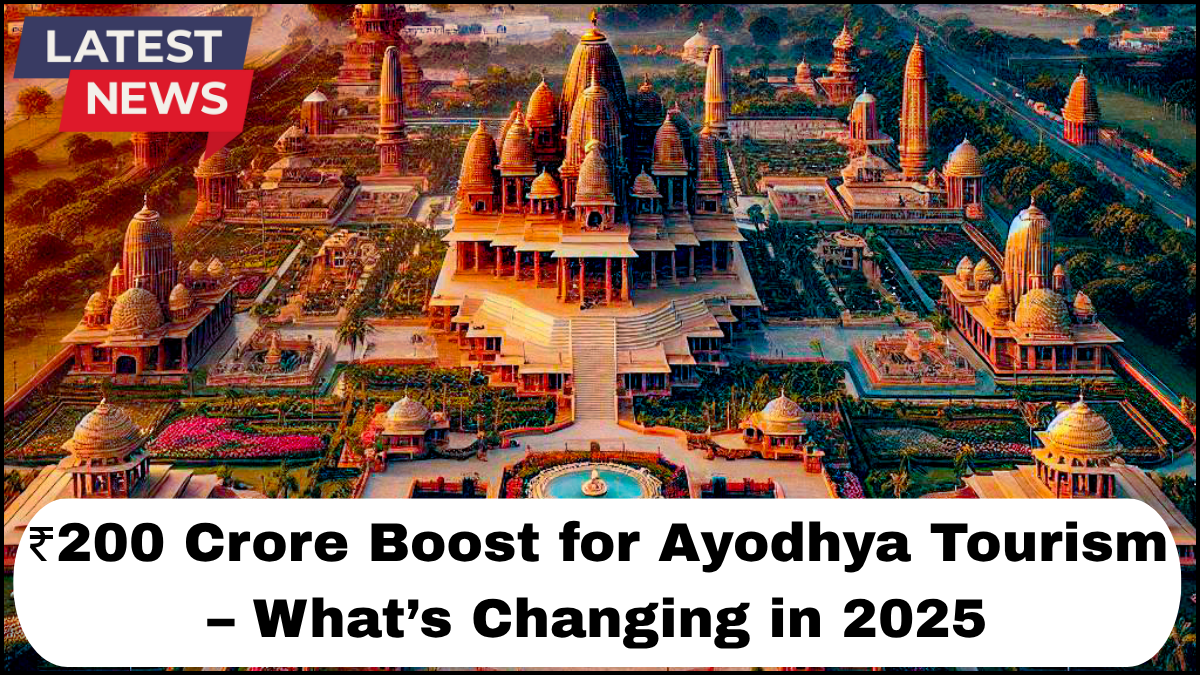The government has unveiled a ₹200 crore Ayodhya Tourism Budget for 2025, marking a significant milestone in the city’s transformation into a world-class spiritual and cultural destination. With a sharp focus on infrastructure, accessibility, and heritage preservation, this massive investment signals a new era for religious travel projects in India.

Here’s a deep dive into what this budget means, how it will reshape Ayodhya, and why 2025 is set to be a game-changer for spiritual tourism.
A Strategic Push for Spiritual Tourism
Ayodhya, known as the birthplace of Lord Ram, holds immense religious significance for millions of Hindus worldwide. The recent opening of the Ram Mandir has already placed the city on the global religious map, triggering a surge in domestic and international pilgrims.
Recognizing the city’s growing popularity, the government has allocated a dedicated ₹200 crore to enhance the Ayodhya Tourism Budget, aiming to strengthen its appeal as a spiritual and cultural hub. This isn’t just about beautification—it’s a strategic move to accommodate the anticipated rise in footfall and ensure world-class facilities for travelers.
Infrastructure Overhaul: Roads, Connectivity, and Cleanliness
A significant portion of the ₹200 crore allocation will go into improving connectivity. Plans are underway to:
-
Widen and resurface major access roads leading to the temple town.
-
Upgrade Ayodhya Dham railway station to handle high-speed rail traffic.
-
Expand Maharishi Valmiki International Airport, ensuring smoother air travel and better international linkages.
Additionally, emphasis is being placed on hygiene and sustainability. Expect modern sanitation facilities, waste management systems, and eco-friendly zones across pilgrimage circuits.
Enhancing Visitor Experience with Smart Amenities
To match the standards of global spiritual destinations, Ayodhya will see the rollout of smart tech-based amenities:
-
Interactive information kiosks for tourists.
-
QR-code enabled self-guided tour options in multiple languages.
-
Digital ticketing systems for attractions and transport.
Moreover, key temple routes will be fitted with smart lighting, CCTV surveillance, and emergency response systems to ensure visitor safety and comfort.
Cultural Revival and Heritage Conservation
One of the core goals of this religious travel project is to preserve Ayodhya’s timeless legacy. The tourism budget earmarks funds for:
-
Restoration of ancient ghats and heritage structures.
-
Creation of interactive museums and interpretation centers showcasing the Ramayana, Ayodhya’s lineage, and related traditions.
-
Organizing regular light and sound shows, cultural festivals, and spiritual workshops.
This holistic approach merges religious sanctity with storytelling and cultural immersion—something that resonates deeply with both domestic and foreign tourists.
Boosting the Local Economy
The expanded Ayodhya Tourism Budget also focuses on empowering the local economy. By 2025, the city expects to create thousands of direct and indirect jobs through:
-
Training programs for local guides, artisans, and hospitality staff.
-
Financial support for homestays, local eateries, and souvenir shops.
-
Partnerships with private players to develop mid-range and luxury accommodations.
This bottom-up model ensures that tourism growth benefits not just infrastructure but also the community.
Aligning with the National Religious Travel Vision
This initiative is part of a broader national vision to elevate India’s position in the global religious tourism sector. With cities like Varanasi, Mathura, and now Ayodhya getting infrastructure upgrades, the religious travel project segment is witnessing unprecedented attention.
Ayodhya’s development serves as a blueprint—showing how religious tourism can drive sustainable urban growth without compromising cultural integrity.
What Lies Ahead?
By 2025, Ayodhya is expected to welcome over 5 crore tourists annually, a leap from the current numbers. With enhanced rail, road, and air access, a richer visitor experience, and increased accommodation options, Ayodhya is poised to become India’s spiritual tourism capital.
The ₹200 crore budget is not just a financial allocation—it’s a signal of intent. A commitment to preserving faith while preparing for the future.
FAQs
What is the purpose of the ₹200 crore Ayodhya Tourism Budget?
The budget aims to improve infrastructure, enhance tourist facilities, promote cultural heritage, and support the growth of Ayodhya as a premier religious tourism destination.
How will Ayodhya benefit from this investment?
Ayodhya will see upgraded roads, a modernized airport and railway station, better sanitation, heritage conservation, and increased employment opportunities for locals.
Will international tourists benefit from these developments?
Yes. The focus on smart amenities, multilingual services, and improved connectivity will make Ayodhya more accessible and welcoming to global travelers.
Is the budget part of a larger religious travel project in India?
Absolutely. This initiative aligns with a nationwide effort to elevate religious tourism, with similar investments in cities like Varanasi, Ujjain, and Mathura.
When will the changes be visible?
Major upgrades are expected to roll out throughout 2025, with some infrastructure and service improvements already underway.
click here to learn more